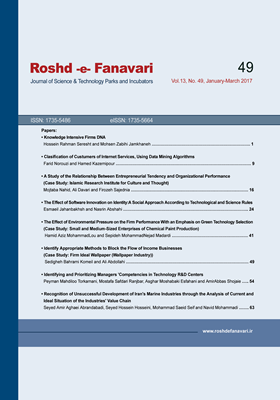Recognition of Unsuccessful Development of Iran's Marine Industries through the Analysis of Current and Ideal Situation of the Industries' Value Chain
Subject Areas : مديريت تکنولوژيSeyed Amir Aghaei Abrand Abadi 1 , Seyed Hossein Hosseini 2 , Mohamad Saeid Seif 3 , Navid Mohammadi 4
1 -
2 -
3 -
4 - University of Tehran
Keywords: Value chain analysis Marine industries Shipbuilding Gap Analysis Maritime supply chain,
Abstract :
Iran's marine industry is of high importance due to the countries 5800 km of coastline, access to the sea in the north and the south, and access to free water although the industry's situation is not as successful as its rivals which started their development plan simultaneously. The purpose of this paper is to examine the gap between current and ideal situation of marine industry to find bottlenecks of development. To do so, the marine industry value chains in other countries are studied and customized with Iran's industry through expert opinions as the first step. Next, private and governmental companies, which have been registered in Iranian Association of Naval Architecture & Marine Engineering, are reviewed and located in the value chain to find industry strengths and weaknesses. Finally, solutions to remove bottlenecks of Iran's marine industry development are proposed. Results are representative of the fact that the majour bottlenecks in supportive activities are the lack of integrated finance and insurance system, occupational skill training system, customs adminstartion, and R&D infrastructure. Moreover, the major bottlenecks in primery activities are lack of vendor list, and weakness of needs & feasibility assessment, supply chain management and technical capabilities. To improve the industry performance, the government should focus on integrated laboratory services, finance and insurance, and regulations to reduce investment risks and private sector should promote its productivity and competitiveness. This research could be used as a basis to formulate Iran's marine industry strategic plan.
1- خبرگذاری صبا http://www.sabairan.com/fa/news/8112.
2- صفارزاده، محمود، عزيزآبادي, ابراهيم، حميدي، حميد، شهبا، محمدعلي، حمل و نقل دريايي, سازمان بنادر و دريانوردي، تهران، چاپ اول، 1385.
3- اثباتي، حسين و طباطبائيان، سيدحبيبالله , تعيين اولويتهاي اكتساب فناوري در يك سازمان صنعتي؛ مطالعه موردي شناورهاي كلاس متوسط- لندينگ كرافت, فصلنامه رشد فناوري, تهران، سال يازدهم، شماره42، 1394.
4- وزارت صنايع و معادن، گزارش مطالعات رشته فعاليتهاي صنعتي (صنايع دريايي)، طرح تدوين استراتژي توسعه صنعتي كشور، تيرماه ١٣٨٢.
5- سيف، محمدسعيد، گزارش پيشنويس سند جامع توسعه دريايي کشور، ستاد توسعه صنايع دانشبنيان دريايي، معاونت علمي و فناوري رياست جمهوري، تهران، چاپ اول، 1389.
6- صندوق توسعه صنايع دريايي، بررسي اجمالي وضعيت صنعت ساخت و تعمير کشتي در ايران، صندوق توسعه صنايع دريايي، تهران، چاپ اول، 1393.
7- صفرقلي، اميرحسين، محمدي، اکبر، نجار تبار بيشه، محمد، آمارنامه دريايي ايران سال 1393، ستاد توسعه فناوري و صنايع دانشبنيان دريايي، معاونت علمي و فناوري رياست جمهوري، تهران، چاپ اول، 1393.
8- فاطمي امين، سيدرضا، جعفرپور، امير و نظرزاده، محمدجواد و نيازي، سيدمهدي، برنامه راهبردي زنجيره تأمين تجهيزات حمل و نقل، جهاد دانشگاهي دانشگاه شهيد بهشتي، تهران، چاپ اول، 1392.
9- انجمن مهندسي دريايي ايران با مشارکت اعضاي حقوقي انجمن و با حمايت مرکز همکاريهاي فناوري و نوآوري رياست جمهوري، صنايع دريايي ايران، انجمن مهندسي دريايي ايران، تهران، چاپ اول، 1392.
10- McCue, Timothy P., The Dynamics of Naval Shipbuilding a Systems Approach to Project Management Assessment, Department of Ocean Engineering, Massachusetts Institute of Technology, 1997.
11- Sung, Anh Nam; Samuel, Naima and Pupipa, Polawat, Competition in the shipbuilding industry, Proceeding of 28th International Conference of the System Dynamics, System Dynamics Society, Seoul, Korea, 2009.
12- Porter M. E, Competitive Advantage: Creating and Sustaining Superior Performance, The Free Press, New York, 1985.
13- Norman, R, and Rairez R, From Value Chain to Value Constellation: Designing Interactive Strategy, HARVARD BUSINESS REVIEW, 1993.
14- Kalafut, Pamela Cohen and Jonathan, Low, The value creation index: quantifying intangible value, Journal of Strategy & Leadership, Vol. 29 Iss: 5, pp.9 – 15, 2000.
15- Cho, Kyu-Kab, Lee, Soo-Hong and Chung, Dong-Soo, An Automatic Process-Planning System for Block Assembly in Shipbuilding, Journal Computer-Aided Design, Butterworth-Heinemann Newton, MA, USA, Volume 45 Issue 12, Pages 1630-1638, 1996.
16- Ckaravastia, andi, and Diawati Lucia, Development Of System Dynamic Model To Diagnose The Logistic Chain Performance Of Shipbuilding Industry In Indonesia, Proceeding of 17th International Conference of The System Dynamics, System Dynamics Society, Wellington, New Zealand, 1999.
17- Seo, Yoonho; Dongmok Sheen and Kim, Taioun, Block assembly planning in shipbuilding using case-based reasoning, Expert Systems with Applications, Volume 32, Issue 1, Pages 245–253, 2007.
18- König, Markus; Beißert, Ulrike; Steinhauer, Dirk and Bargstädt, Hans-joachim; Constraint-based simulation of outfitting processes in shipbuilding and civil engineering, Proceedings of the 6th EUROSIM Congress on Modelling and Simulation, Wien, 2007.
19- Brun , Lukas; Gereffi, Gary; Stokes Shawn & Guinn Andrew, The NSPS Shipbuilding Value Chains, Center on Globalization, Governance & Competitvness, Duke University, 2013.
20- CESA, Community of European Shipyards Associations Report, 2012.
21- Van Coller, J., Maasdorp, G. and Mavundla, K., Durban Maritime Industry:A Value-Chain Analysis, Health and Social Services, Unpublished Report, 2007.
22- UNDP, Is the Private Sector More Efficient? A cautionary tale, UNDP Global Center for Public Service Excellence, Singapore, 2015.


